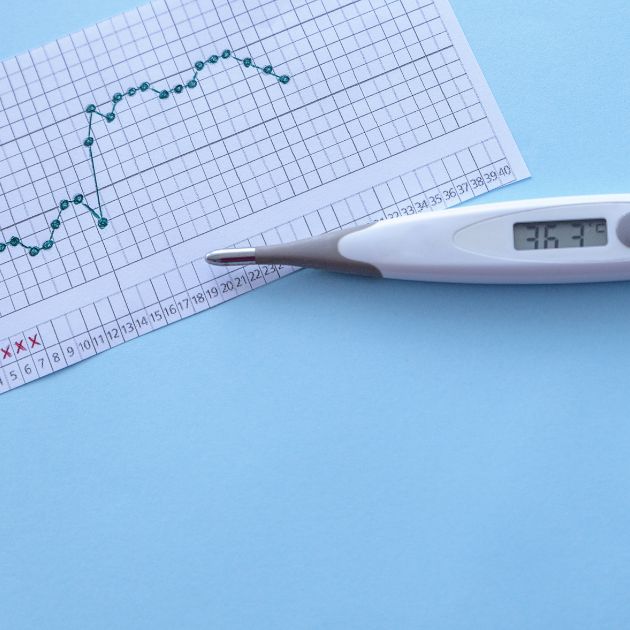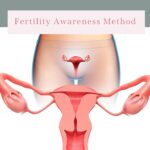To plan a second pregnancy at the “advanced” age of 35 (cue eye roll), I wanted a natural family planning option that was evidence-based, non-invasive, and free from third-party apps looking to sell my private health data for profit. It seemed like a tall order!
That’s when I discovered the Fertility Awareness Method, a fertility tracking system that gives you a daily snapshot of your fertility status using just a thermometer, a pencil, and a piece of paper.
With FAM, I got a crash course in my own body and hormonal cycles. I even knew I was pregnant days before I tested positive! Sounds intriguing, right? Let’s take a look at how the method works and whether it’s right for your conception journey.

This site contains affiliate links, meaning that we earn a small commission for purchases made through our site. We only recommend products we personally use, love, or have thoroughly vetted.
- What Is The Fertility Awareness Method?
- What Are The Benefits Of Using The Fertility Awareness Method?
- What Are The Disadvantages To The Fertility Awareness Method?
- Is the Fertility Awareness Method Right For You?
- My Favorite Resource For Learning The Fertility Awareness Method
- An Average Day Using The Fertility Awareness Method For Natural Family Planning
- Try Natural Family Planning With The Fertility Awareness Method (FAM)
What Is The Fertility Awareness Method?
If you’re a fertility research veteran like our founder Katy, you already know the term “fertility awareness.” The medical community uses the term to describe a variety of individual fertility tracking methods like the basal body temperature method, cervical mucus monitoring, or the much-maligned rhythm method/calendar method.
On their own, each of these is somewhat effective in determining fertility status.
The Fertility Awareness Method (FAM) covered today combines three biological fertility awareness methods plus multiple other data points like your menstrual cycle, illness, exercise, stress, ovulation test results, medications, and individually selected symptoms.
FAM utilizes a comprehensive approach, and as a former epidemiologist, I think it wins the prize for the most evidence-based natural family planning tool I’ve found.
Get To Know The Three Pillars Of FAM
FAM relies on three major data points to determine your first fertile day and your last fertile day in each cycle – basal body temperature, cervical fluid, and cervical position.
A fertile day means your chances increase for conceiving a baby. If an egg meets a sperm these days, you’ve got a shot at getting pregnant. (Most women have 3-6 fertile days per cycle depending on their age and other factors.)
How does each of the three fertility markers mentioned above identify fertile days? Good question!
- Basal Body Temperature
Your basal body temperature (BBT) is the temperature of your body at rest. It requires a special (but inexpensive) thermometer that reads your body temperature to two decimal points.
BBTs before ovulation read lower than those after ovulation. When you see a “thermal shift” or jump in your body temperature, you know you’ve ovulated.
- Cervical Fluid
Sperm need nice slippery fluid to make the long journey through the cervix, the uterus, and into a fallopian tube for fertilization.
The Fertility Awareness Method teaches you to recognize “egg white” or “creamy” cervical fluids – the best kind for a sperm slip-n-slide.
- Cervical Position
Around ovulation, your cervix undergoes several changes to prepare for a possible pregnancy. A cervix during your most fertile days feels soft, wet, open, and at its highest point in your vagina. More info on that later!
What Are The Benefits Of Using The Fertility Awareness Method?
FAM empowers future birthing persons with real information about their reproductive health. It forces you to tune into your body’s hormonal cycles, their length, and their associated symptoms.
I learned so much about myself using FAM in my mid-30s and wondered why no one told me about this stuff in middle school. Why was this not a required class!?
Besides greater knowledge of your own body, you also benefit from the absolute privacy of tracking your health information without a mobile application or website.
(If you love using your app for timing sex, I get it! It’s so darn convenient. I’m hopeful for more private period and ovulation trackers in the future. Until then, FAM offers an immediate low tech alternative.)
Finally, whereas my former ovulation tracker app set me back $89 per year, FAM requires little investment. A simple basal thermometer costs around $10, and all the charts you need are available for free at the TCOYF website.

What Are The Disadvantages To The Fertility Awareness Method?
FAM data collection relies heavily on your hormonal cycle and its predictability. To use FAM, you must get an accurate and consistent basal body temperature at the same time of day for perfect use. Number crunchers like me love this, but to others, it might seem tedious.
In addition, you gotta get down and dirty with yourself, but not like that!
You observe your cervical mucus (color and texture) on a piece of toilet paper or your fingers every day.
You also use your clean bare finger inserted into your vagina to check your cervix position. It’s all in the name of understanding your fertility, but everyone has a different comfort level with their body.
Finally, observing your body’s natural patterns takes time. I gained confidence in my ability to predict my own cycles within 3-6 months of using FAM consistently, but I know even 3 months feels like an eternity when you’re trying to conceive.
Is the Fertility Awareness Method Right For You?
When You’re Trying To Conceive
Most people trying to conceive will benefit from learning more about FAM, especially using the resource book shared below.
Understanding the ways your ovaries and other reproductive organs respond to illness, exercise, travel, weight changes, or stress, can transform an anxiety-inducing mystery like anovulation or irregular menstruation into something normal and even expected.
For instance, I experienced a lighter, longer period following a COVID-19 infection. With FAM, I knew this was common after a viral illness.
Unless you’re deep into your own infertility journey and already working with trusted health professionals, FAM also helps you ask important questions at your doctor’s appointments and make informed decisions about next steps.
(Find a wealth of additional resources on infertility at Undefining Motherhood. Start with our articles “What Is Infertility?” and “Infertility Testing”.)
When You’re Trying NOT To Conceive
If used consistently, FAM prevents pregnancy as effectively as the birth control pill or even an IUD. Even with typical use, FAM’s accidental pregnancy rates are similar to barrier methods like condoms or a diaphragm. Who knew!
People using FAM for pregnancy prevention must be willing to postpone sex until after their fertile days are over or use a barrier method during that time. Most individuals using FAM record around 10 “no-sex” days a month.
The rules around FAM as a form of birth control require some study and practice, but for people looking for non-hormonal, non-invasive contraception options, the tradeoff seems more than reasonable.
Finally, those of us with certain lifestyle factors impacting our hormones and ability to chart reliably should consider another type of birth control. These factors include breastfeeding, frequent travel between time zones, shift work, excessive alcohol use, and STIs or medications impacting cervical fluid production.
My Favorite Resource For Learning The Fertility Awareness Method
When it comes to learning the Fertility Awareness Method (FAM), look no further than the book Taking Control Of Your Fertility: The Definitive Guide to Natural Birth Control, Pregnancy Achievement, and Reproductive Health by Toni Weschler, MPH.
With a mouthful of a title, fans of the book call it “TCOYF” for short. And there are fans! Reviewers on Amazon call the book “life-changing” and “the most comprehensive book on fertility.”
The author blends her conversational writing style with an encyclopedic knowledge of women’s health issues. I read the entire thing (over 500 pages including a 19-page bibliography) cover to cover in just a few days.
Bonus: Many local libraries carry this book. I routinely check out the most updated version from my library whenever I need a refresher. I even checked it out to write this article. You can’t beat free!
A Quick Note About Taking Control of Your Fertility by Toni Weschler
At Undefining Motherhood, we celebrate the many ways of being a modern woman and mother. The book TCOYF addresses topics relevant to all uterus-owning individuals, but it often focuses on heterosexual couples.
The book also discusses some emotionally triggering topics such as natural gender selection, miscarriage, infertility, heterosexual sexuality, and declining fertility over the age of 35.
Fortunately, the author, a health educator, approaches these topics with sensitivity, and sections are easily skipped or revisited later without missing key information. Take what you need and leave the rest!

An Average Day Using The Fertility Awareness Method For Natural Family Planning
At 5:30 am my alarm buzzes, notifying me it’s time to take my morning temperature. I record it on the chart by my bed, clicking my mechanical pencil a few times.
I set an alarm to ensure I get a temperature at the same time every day. I set it early in hopes of enjoying a fresh cup of coffee in silence before my 3-year-old barrels into the living room seeking my attention.
Around lunch, I take a bathroom break. I wash my hands thoroughly and check my cervical fluid and cervical position by gently inserting a couple fingers into my vagina while sitting. I use an infographic chart like the one in the TCOYF to remind me where to find my cervical position at each stage of my cycle.
A firm cervix feels like the tip of your nose, but a soft cervix feels more like your lips. Sometimes my short little fingers can’t reach my cervix at all, and in that case, I know it’s at its highest position.
I’ve gotta run to an appointment, so I plan to add my observations to my chart later.
At bedtime, I record final notes on my chart including exercise, sexual intercourse, or notable symptoms. I estimate some upcoming fertile days in my head and chat with my husband about the best days to have sex. (Kinky stuff, huh?)
Getting Pregnant With The Fertility Awareness Method
From charting so consistently (6 months of tracking), I’m fairly confident in my estimates and in my ability to explain any weirdness in my chart caused by travel, stress, or illness.
I also know from charting that my luteal phase (the period between ovulation and the first day of my period) is always 10 days long with plunging body temperatures. Don’t be wowed! I’m nothing special! Many people experience a consistent luteal phase.
Being familiar with how my normal luteal phase looks, I knew something was amiss when my normally dipping body temperatures stayed super high. This is it! I’m finally pregnant!
In fact, I recognized my pregnancy a full six days before early detection pregnancy tests. Amazing!
Try Natural Family Planning With The Fertility Awareness Method (FAM)
The Fertility Awareness Method, often lumped in with less effective methods, uses evidence-based measures for tracking fertility.
FAM empowers women to deepen their knowledge and understanding of their own reproductive systems. Knowledge is power, y’all!
FAM also provides an alternative to fertility tracking apps and software that share your private health data with outside parties. FAM may even be a viable non-hormonal birth control option if used correctly and consistently.
For those seeking a natural family planning solution, consider the Fertility Awareness Method!
Have you used the Fertility Awareness Method to conceive? Share your natural family planning successes and challenges below!










